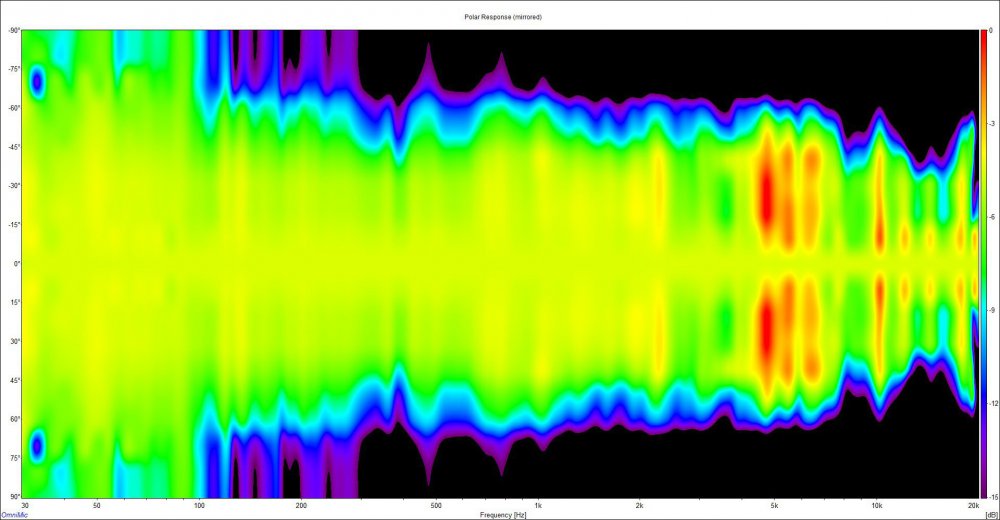-
Posts
9702 -
Joined
-
Days Won
15
Chris A last won the day on September 20 2023
Chris A had the most liked content!
Profile Information
-
Gender
Male
-
Location
Arlington, Texas, USA
-
Interests
Acoustic horn design (multiple entry horns), DSP crossover optimization using acoustic measurements, and music track demastering to remove mastering EQ/clipping, etc.
- See My System
Contact Methods
-
Website URL
https://drive.google.com/drive/folders/0BwQoJ7rtphauWHhtZEZndUw4M0U
Recent Profile Visitors
Chris A's Achievements
-
See the following from this thread:
- 232 replies
-
- jubilee
- buyers guide
-
(and 1 more)
Tagged with:
-

Active Crossover for La Scala via MiniDSP
Chris A replied to 1bigpig's topic in Technical/Restorations
I believe that this is entirely a function of the channel gains, delays, and PEQs that you've set in the 4x10 HD. If you want to match the exact presentation of the passive crossovers, that's very doable. Just measure the SPL and phase response of the loudspeakers with passives, then transfer that response to the DSP crossover. Voila! An exact match. Chris- 16 replies
-
- 1
-

-
- active
- active digital crossover
- (and 4 more)
-

An attempt to build K-402-MEH clone in wood
Chris A replied to StabMe's topic in 2-Channel Home Audio
Any corner of the room will do for placement. In my instance, it has to be the front corners on top of the TH subs. I squeeze down on the space behind the traps by shifting them slightly toward the middle of the room (while their edges remain in contact with the corner's walls) in order to reduce their effectiveness a bit. This is a nice way to adjust just how much they are absorbing via listening and shifting them around. The bass traps are only good down to 70 Hz (the 1/4 wavelength corresponding to the length of the panels), below which in frequency they don't do any effective absorbing. So most of the corner-horn boundary gain is still intact (i.e., below 70 Hz) even with the traps in the same corners. The "boominess" of the 100-200 Hz band is however controlled in room, which is their main purpose. Below 70 Hz, the room modes and drywall flex are the main controlling elements of the bass response. In fact, I have to place stiffeners along the side walls next to the corner-located TH sub mouths in order to reduce drywall flexing. This really improves the in-room response below 30-35 Hz and down to 16.5 Hz, where a room-width mode appears to attenuate at that frequency. Chris -

An attempt to build K-402-MEH clone in wood
Chris A replied to StabMe's topic in 2-Channel Home Audio
I haven't looked at the absorption coefficients vs. frequency of the 703 vs. 705 in many years. In general, you're looking for relatively equal absorption vs. frequency (flat absorption plot lines). If your room's RT values look like the 705 would be a better fit (i.e., the absorption values of 705 increase at frequencies where the RT values also increase), then the 705 material might be a better choice. Also, be mindful its lower frequency absorption coefficients, too, in the midbass and lower treble range. Yes. The problem with using diffusors in this critical area near the horn mouths is that it's difficult to get really broad band diffusion of high enough efficiency. I find it easier to use the 0.6x0.6 m squares to make sure that all early reflections are effectively controlled. You have to use enough absorption somewhere (or have a large enough room wall area) to get the high RT values down to reasonable values. You can place these absorption panels spaced out among diffusion panels, even alternating with absorption/diffusion, etc. Chris -

An attempt to build K-402-MEH clone in wood
Chris A replied to StabMe's topic in 2-Channel Home Audio
If you place the horn mouths within 2 feet (0.6 m) of a side wall, I then recommend a line of 1" (2.5 cm) thick laundry-lint-type squares of 2 feet by 2 feet dimensions (0.6 x 0.6 m) placed just adjacent to the horn mouth exits. This will dramatically help to recapture the phantom center stereo image, in my experience. You can experiment using more squares just around the horn mouths--out to perhaps 6 feet (2 m) radially. You may need to place more absorption along the side walls, carpet on the floor, etc. to help control the nearfield reflections to the loudspeakers--and the listening positions. Chris -

An attempt to build K-402-MEH clone in wood
Chris A replied to StabMe's topic in 2-Channel Home Audio
Yes. I use double Owens-Corning 703 fiberglass panels (total 4" thick each) in ATS Acoustic bags. They are placed across the room corners and are closed on one end (sitting on top of the TH-SPUD DIY subwoofers in each front corner). It's important that one end is closed off in order to make it a 1/4 wavelength trap (down to ~70 Hz based on the panel length). If you leave both ends open, then it becomes a half wavelength trap (i.e., 140 Hz). Chris -
There are a lot of EQ products on the market. Melda makes a range of equilizers, one of which is free, and two of which are "automatic". I assume it's semi-automatic based on the spectra used in a reference track. I don't personally use any of these, preferring instead to demaster my tracks using Audacity so that I don't have to use an EQ plugin at playback time. Chris
-

An attempt to build K-402-MEH clone in wood
Chris A replied to StabMe's topic in 2-Channel Home Audio
I'd say you've got a lot of work to do on controlling your reverberation times (RTs) unless you have an extremely large listening room. I'd aim for at least reducing the RT30 values to below 1 ms, with 0.4-0.5 ms being much more workable. I''d make sure that the curve smoothing is set to "psychoacoustic" before trying to EQ anything. Overall, the closer you can get the SPL response to plus/minus 3 db using psychoacoustic smoothing, the better it will sound. Plus/minus 2 dB is even better. I recommend using REW's EQ facility to do this. It looks like the gain of the bass bin is set too low, and you're trying to boost the 100 Hz notch in response. I'd instead recommend boosting the overall bass bin channel, then attenuate the 200-500 Hz band, then boost the 70-130 Hz portion using no more than 3-4 dB. That way, you'll be avoiding using too much PEQ gain, which can cause internal issues with a DSP crossover. Chris -
The Emotiva XMC-1 and subsequent Emotiva pre/pros do have good SINAD performance as compared to even the Anthem pre/pros, and they come with Dirac (which is easily updated to Dirac Live Full for about $100). A pre/pro is nothing but a glorified multichannel DAC with gain control, so SINAD performance is a reasonable way to grade the pre/pros. I would pay attention to that, as that's about the only thing that I can even slightly tell the difference between pre/pros in terms of sound quality. I've also stated that the Emotiva XMC-1 firmware is less smooth and mature as compared to, say, Onkyos. This is a minor annoyance in practice I've found, as I don't tend to jump around from source-to-source very much (I only use only two players and one computer--all on HDMI). There are some transitions that still produce a bump in the audio stream, and things can get hung up on video switching of streams, but nothing that's serious. However, as I've mentioned elsewhere, all of the "room correction software" packages do have consistent problems trying to take measurements too far away-- at the listening position(s) instead of nearfield, and in fact are trying to correct for non-minimum-phase response (something that you really can't do) below about 500 Hz. I've documented this. This is really annoying in that it would take very little for the folks at Dirac to provided a "move the mike' option between loudspeakers in order to first correct the EQ and phase response, then one more at the listening position to correct the time-of-arrival (distances) from each loudspeaker. This would basically solve the EQ problems. All the room correction software packages are trying to ignore the fact that a listening room is not an anechoic chamber, and they are not paying attention to getting rid of the non-minimum phase reflections in their measurements by moving the microphone too far back away from each loudspeaker under test. Klipsch has announced that it's acquired Onkyo this past summer, so that might be a consideration, too, in that newer pre/pros may come out that have settings more conducive to Klipsch branded loudspeakers. Again, YMMV. Chris
-
It actually could be an amplifier clipping if using amplifiers with less than ~8 w/channel of clean output. It could be that you don't hear that clipping using other loudspeakers of lower efficiency because their clarity is so much lower. The issue with the K-400/K-401 midrange horn is twofold: 1) It loses vertical directivity below 2.1 kHz (due to the limited size of its mouth in the vertical direction), thus putting a lot of acoustic energy on your ceiling and floor. You can help with controlling this excess energy on the floor easily (thicker absorption material on the floor near the loudspeaker), and something on the ceiling to diffuse the 400-2100 Hz energy better. 2) It's not time aligned with the tweeter and bass bin. This produces the timbre shifts and the "stuffy" sound that you have identified. The best solution is a pair of K-402s with Celestion Axi2050 drivers, bi-amped (bass bin and HF K-402) using good direct-coupled amplifiers. These would probably be the best sounding that you've ever heard-no kidding. The range of lesser solutions is enormous. I really don't recommend half-measures if ultimate sound quality--like the Dunlavy SC-IIIs and the little speakers-on-a-stick are your prior reference for sound quality. You're apparently used to hearing phase-coherent loudspeakers, and the bi-amped K-402/Axi2050/Khorn bass bin will provide that if using a good DSP crossover You really need horn-loaded subs in order to keep the distortion levels down to reasonable levels. Otherwise the little direct radiating subs stick out like a sore thumb. I recommend tapped horn subwoofers, but any front-loaded horn subwoofer combinations having lower end cutoff below 20 Hz is probably the only reason to use subs with the Khorns (IMHO). The Khorns are good down to 32 Hz in room corners. All of these problems will be solved with the K-402/Axi2050 horn/driver (bi-amped) on top of the bass bins. Save your pennies and do it all at once--and you'll thank yourself later. You can store the passive crossovers and top hats for resale later if you wish--via reassembling the them on top. The top hats just unbolt from the bass bins and can be stored away. It's clearly not a losing battle but it takes some surgery to solve the problems you have brought up, above, assuming that you've imprinted on phase-coherent loudspeakers. The K-402s (Klipsch won't let you buy these with the Axi2050s the last time I looked, but you can ask if they will put the new "K-693" drivers instead of the K-691s) are the solution, IMO. If the price is too high from Klipsch to do this, then just buy the K-691s on the K-402s with a stand (also known as a KPT-402-HF assembly), then buy the Axi2050s separately then integrate them, replacing the K-691s, then sell the K-691s off separately. You'll never look back after doing this, and I'd go as far as to say that you will never want for better loudspeakers--ever again. You can talk to user @Delicious2 about using the K-402s on top of the Khorn bass bins. I don't think he's used Axi2050s, but he's used very good replacement compression drivers in the place of the K-691s, IIRC. Chris
-

Active Crossover for La Scala via MiniDSP
Chris A replied to 1bigpig's topic in Technical/Restorations
I use an old foam rubber mattress topper, but anything that's relatively thick will do--such as several thick blankets laid out horizontally between the microphone and loudspeaker under measurement. Yes. It works just the same as passive in terms of phase growth--unless you're using FIR filtering, in which case you can control both amplitude and phase vs. frequency, but typically at a greater required level of computing capability (especially at lower frequencies). That's a great idea. I think it will be a pretty big revelation/eye-opener. I know that I was ready to sell a pair of Belles, one of which I was using between Jubilees, and until I tri-amped and flattened the SPL response, I didn't think it was going to work at all. Short story: it did work... Chris- 16 replies
-
- 2
-

-
- active
- active digital crossover
- (and 4 more)
-

Active Crossover for La Scala via MiniDSP
Chris A replied to 1bigpig's topic in Technical/Restorations
Here's an example of using excess group delay to find the needed channel delay adjustments: Sometimes as you get very close to the correct delays, you'll find that inverting the polarity of either the higher frequency or lower frequency driver channel will bring the two channels closer together in terms of excess phase or group delay (i.e., the first derivative of the phase curve). Chris- 16 replies
-
- 2
-

-
- active
- active digital crossover
- (and 4 more)
-

Active Crossover for La Scala via MiniDSP
Chris A replied to 1bigpig's topic in Technical/Restorations
I've not used outdoor measurements to correct the SPL response, only to do polar coverage measurements--like this one: The notion that you have to do outdoor measurements to correct for in-room response really doesn't work very well, I've found (i.e., in my experience). It's better to use 1 m measurements in front of each loudspeaker in-room with plenty of absorption material on the floor between the loudspeaker and microphone. I've also found a lot of opinions from folks on other audio forums that have some very strange notions of what they can and (more importantly) can't do--that are actually not very well calibrated opinions. The best thing to do is to make different measurements in-room for yourself and compare results. That seems to be a unique point of view to those that hold those strange notions of how "not to do it". Even the low frequencies--which begin to come into nearfield measurement at frequencies below 200 Hz--are better measured in--room at 1 m, and if you get below ~50 Hz, then you can shift to listening position measurements--due entirely to room mode effects all over the room. This is usually the case for everything but perhaps a Klipsch Cornwall with its long midrange horn and direct radiating 15" woofer. Even then, the amount of bass channel delay is very small relative to the wavelength periods at crossover. As you might know, the order of the crossover filters used also affect the required channel delays. If, for instance, you use first order filters instead of eighth order filters, the needed delays will decrease by 90 degrees of phase per decrease in order of filter employed. If you look at the phase response (assuming you've got absorption material on the floor to absorb early reflections between the microphone and loudspeaker), you can read the needed higher channel delay to add or subtract directly from the excess group delay plot. In terms of hitting the delays right--it is possible, especially knowing that you can make microsecond adjustments in the channels. If you look at the excess group delay lag or lead as you decrease in frequency (after punching the "generate minimum phase" or "generate minimum group delay" button), then you can read the exact amount of channel delay to add to the higher frequency channel. You might need to zoom in pretty far on the vertical axis to read it correctly for the higher frequency channels since the wave periods are very short. Here's a thread on that topic: Yes--and that should be made clear to all that are thinking about going down this path, too. Better sound quality is better sound quality. Chris- 16 replies
-
- 2
-

-
- active
- active digital crossover
- (and 4 more)
-
Make sure that the mumps version is also EQed flat before trying to evaluate the sound differences. If you think about it, the difference in sound (after EQ in both cases) shouldn't be much different, with the only real difference being a little wider polar coverage around an octave above the cutoff point (about 1-1.5 kHz) with the mumps version. Chris











.thumb.jpg.3535e91246cda1dfdc74fd22b2fe3bd9.jpg)
